Key takeaways
- Pavlova is characterized by a crispy meringue shell and a soft center, relying on fresh, room-temperature egg whites for the ideal texture.
- Key ingredients include superfine sugar for a glossy finish and vinegar or lemon juice for stabilization and tanginess.
- Choosing perfectly ripe fruit for toppings enhances the dessert’s flavor and texture; overripe fruit can lead to sogginess.
- Assemble the Pavlova just before serving to maintain the crispness of the meringue and the integrity of the toppings.
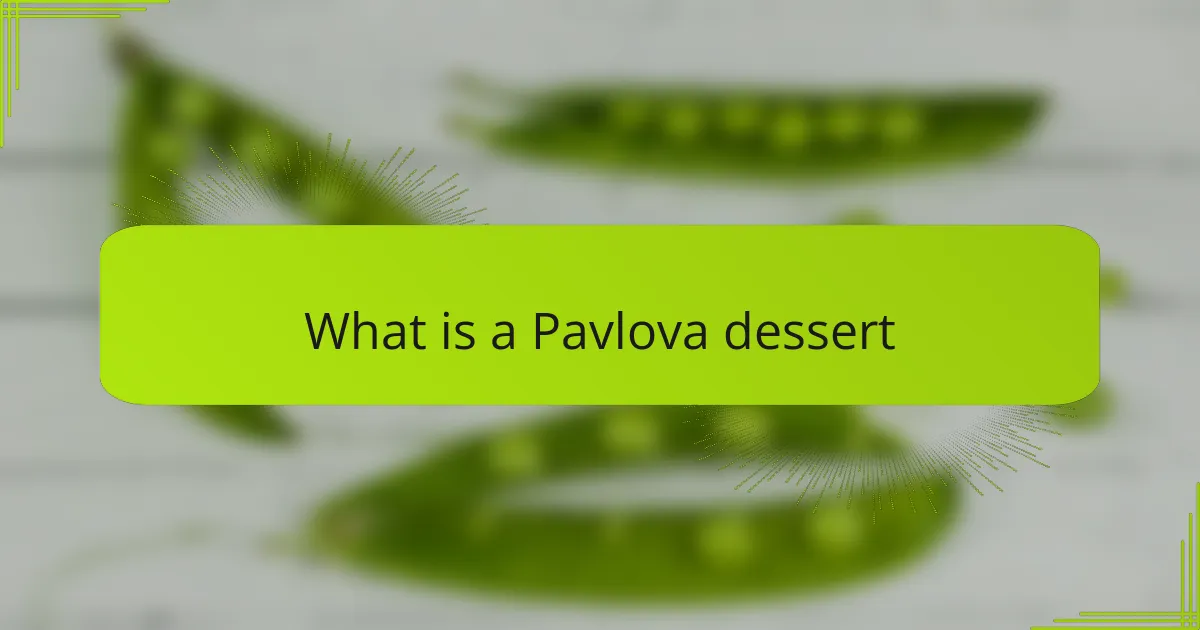
What is a Pavlova dessert
A Pavlova dessert is essentially a crispy meringue shell with a soft, marshmallow-like center. When I first tried it, I was amazed by this contrast—it feels like biting into a cloud with a delicate crunch. Have you ever wondered how something so simple can create such a memorable texture?

Essential ingredients for Pavlova
When I set out to make Pavlova, the first thing I realized was how crucial the eggs are. It’s the egg whites that give the meringue its airy, crisp texture, so using fresh, room-temperature eggs really makes a difference. Have you noticed how even small changes in ingredients can completely alter a dessert’s outcome? I sure have, especially with Pavlova.
Sugar is another non-negotiable element. I prefer superfine sugar because it dissolves quicker, helping to achieve that glossy, stiff peak stage that’s essential for a perfect Pavlova. Without the right sugar, the texture can turn grainy, and nobody wants that—trust me, I learned that the hard way early on.
Vinegar or lemon juice might sound unusual for a dessert, but they stabilize the egg whites and add a subtle tang that brightens the sweetness. Adding these small but vital ingredients feels like sharing a secret—once you include them, your Pavlova suddenly has that professional, light-as-air lift. Have you ever experienced that “aha” moment in baking? This is one of mine.

Preparing the meringue base
Getting the meringue base just right is where the magic truly begins. I remember the first time I whipped the egg whites—I almost gave up because they wouldn’t stiffen. But then I realized that any tiny bit of yolk or grease can sabotage the whole process. Have you ever been frustrated by a simple step that seems to ruin everything? That’s why I make sure my bowls and tools are spotless and completely dry before starting.
Whipping the meringue to stiff peaks is like a little victory dance in the kitchen. I usually start on a medium speed and gradually ramp up, watching for that glorious shiny texture. The moment the peaks hold their shape but don’t look dry is when I know I’ve nailed it. It feels so rewarding to see something so fragile transform into a sturdy yet delicate structure.
Adding the sugar slowly is another key that changed the game for me. Sprinkling it in bit by bit while whipping prevents the meringue from collapsing and gives it that beautiful glossy finish. Trust me, rushing this part only leads to grainy messes—I’ve been there! Patience really pays off when preparing this base, don’t you agree?
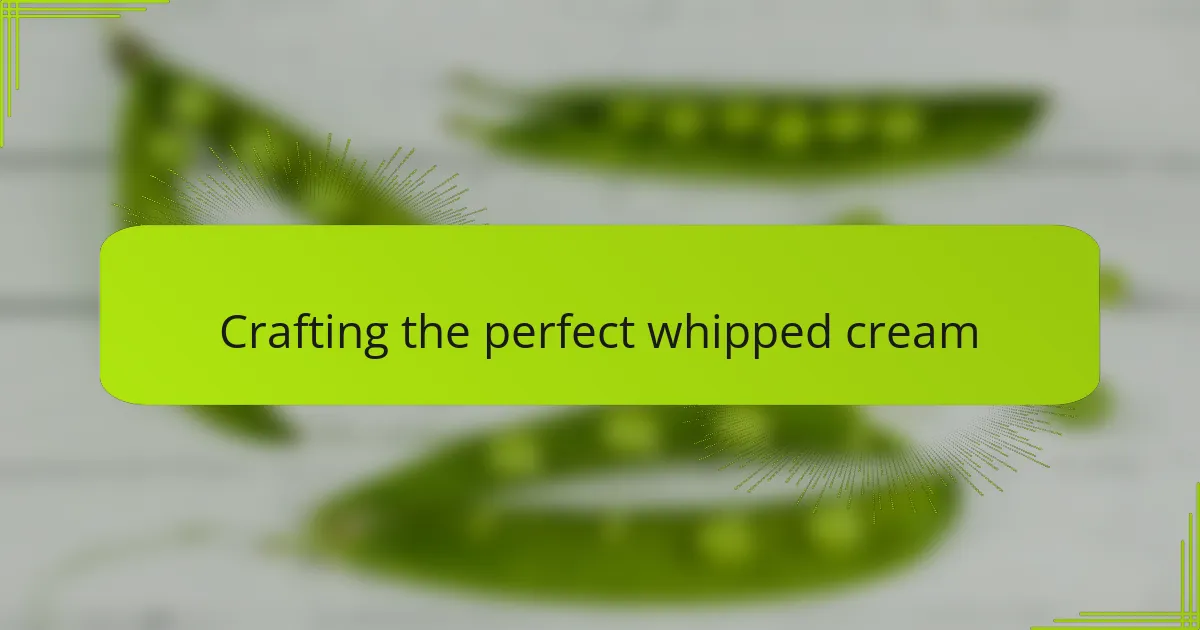
Crafting the perfect whipped cream
Whipping cream to the perfect consistency isn’t as simple as it seems. I’ve lost count of how many times I’ve overwhipped it, turning what should be soft, billowy clouds into a grainy butter disaster. Have you ever felt that frustration when something goes from creamy to clumpy in a blink? I learned to stop whipping just as the cream starts to hold soft peaks—this gentle moment is where the magic lives.
The choice of cream matters too. I always opt for heavy cream with at least 35% fat because lower-fat versions just don’t hold their shape well. When I first made Pavlova with lighter cream, the topping wilted too quickly, and the whole dessert lost its charm. It was a gentle reminder that quality ingredients directly affect the outcome, especially when it comes to whipped cream.
Adding a touch of sweetness and a hint of vanilla makes all the difference. I like to sprinkle in powdered sugar gradually while whipping, which helps stabilize the texture without weighing it down. Have you tried that subtle sweetness that heightens the cream without overpowering the dessert? It’s a small detail, but it makes the whipped cream feel like a perfect, pillowy complement rather than just a topping.
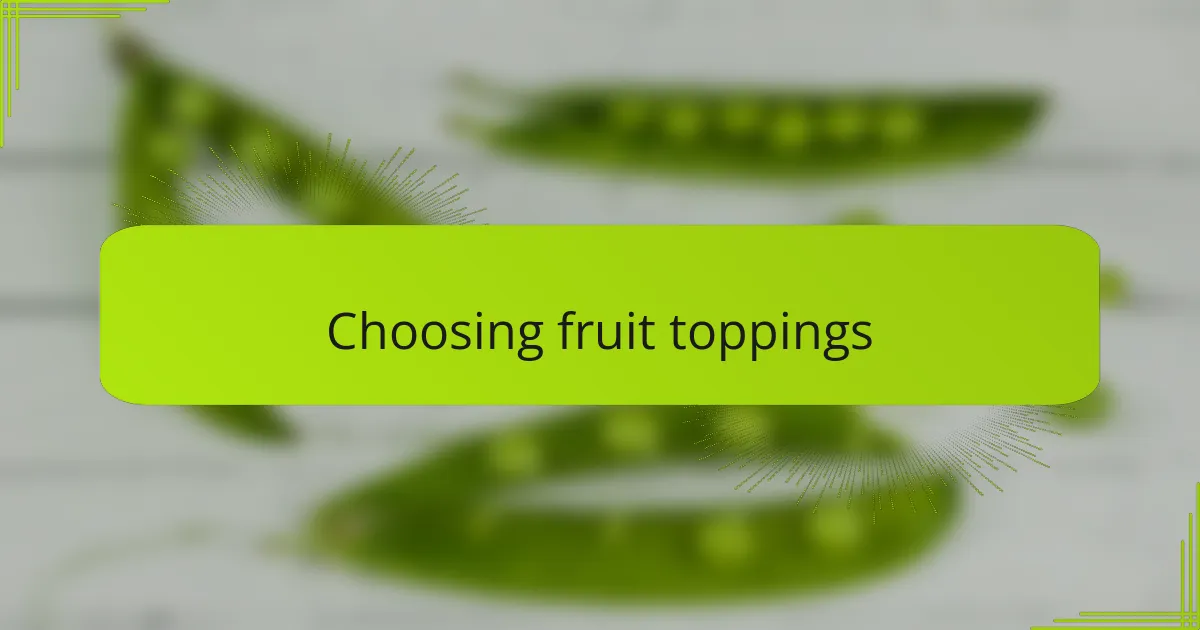
Choosing fruit toppings
Choosing fruit toppings for Pavlova always feels like the final, fun part of the process to me. I tend to pick fruits that offer a balance between tartness and sweetness—like fresh kiwi or tangy passionfruit—to cut through the dessert’s rich creaminess. Have you noticed how the right fruit can brighten the whole dish and add that vibrant pop of color?
Sometimes, I enjoy mixing textures by adding berries alongside slices of stone fruit like peaches or nectarines. The combination of juicy and slightly firm fruit layers gives each bite a delightful complexity. I remember the first time I tried this mix; it instantly elevated my Pavlova from simply pretty to irresistibly delicious.
I’ve also found that the ripeness of the fruit matters more than you might think. Overripe fruit can make the Pavlova soggy, which is a heartbreak after all that effort. So, choosing fruit that’s perfectly ripe but still firm ensures every forkful is fresh and satisfying—don’t you agree that careful fruit selection is worth the few extra minutes of thought?
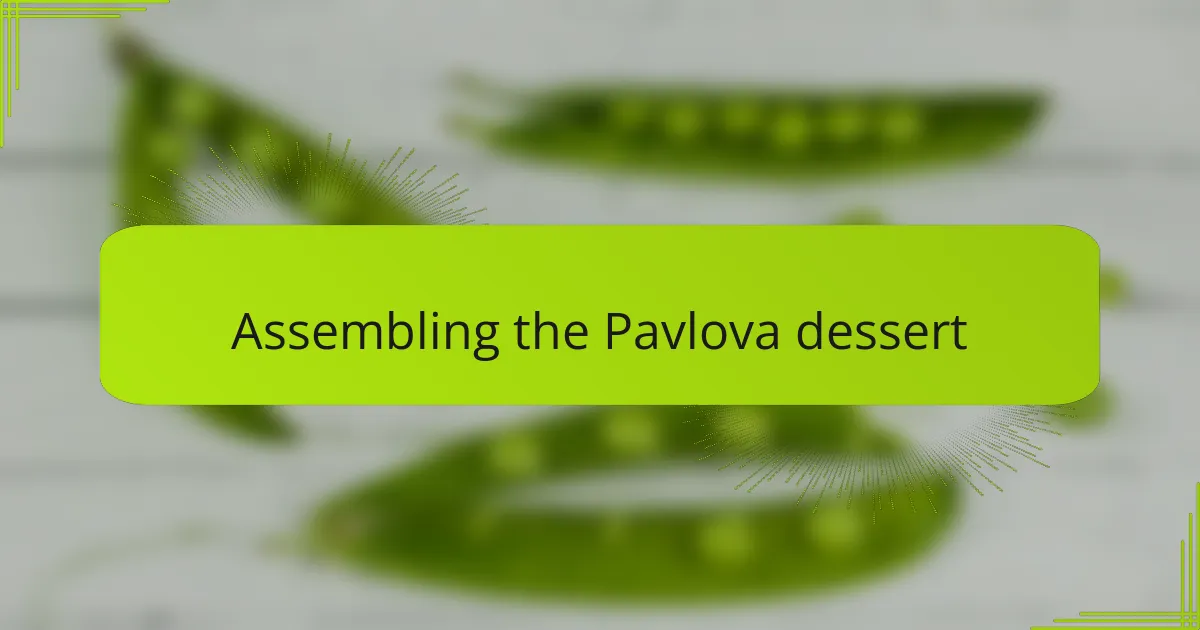
Assembling the Pavlova dessert
Assembling the Pavlova is where everything comes together like a beautiful dance. I find gently spreading the whipped cream over the cooled meringue quite meditative—too thick, and it overwhelms the delicate base; too thin, and it’s just not satisfying. Have you ever stood there wondering if you’ve piled on just enough? That moment always keeps me on my toes.
Adding the fruit toppings is like painting a final stroke on a masterpiece. I remember nervously arranging each piece, worrying about balance and color, but then stepping back and realizing it looks stunning without being perfect. Don’t you love how a simple touch of fresh fruit can instantly elevate the whole dessert?
One tip I swear by is assembling the Pavlova just before serving. I’ve learned from experience that if you wait too long, the fruit’s juices start to seep into the meringue, turning that crisp shell soggy—a total heartbreak after the careful preparation. So timing is everything when it’s time to bring all those textures and flavors together.
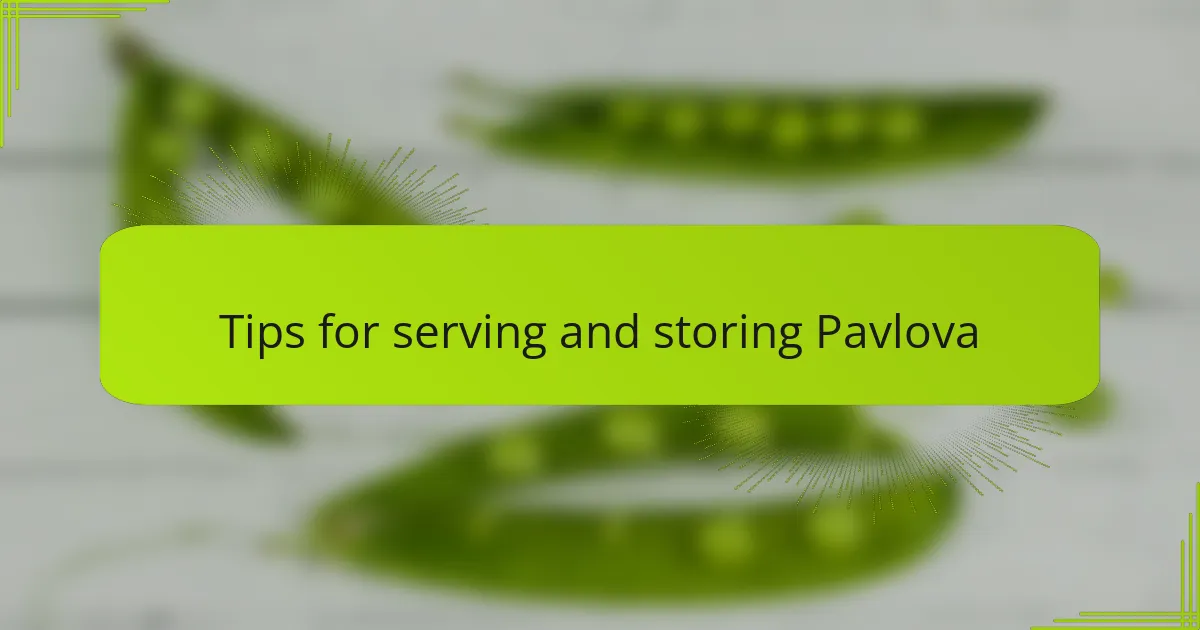
Tips for serving and storing Pavlova
When it comes to serving Pavlova, I’ve found that timing really makes or breaks the experience. Have you ever bit into a Pavlova that lost its crispness? To avoid that disappointment, I always assemble it just before serving, so the meringue stays beautifully crisp under the fresh cream and fruit. It’s such a relief knowing each bite has that perfect crunch combined with creamy softness.
Storing Pavlova can be a bit tricky, but I’ve learned some tricks over time. If I need to keep it for later, I store the meringue base separately in an airtight container at room temperature to preserve its texture. Once I’m ready to serve, I add the cream and fruit fresh—this way, I avoid that soggy mess that happens when moisture sneaks in too early. Have you tried this separation method? It really saves the dessert’s signature texture.
And when it comes to leftovers, if there are any (which is rare in my house), I cover the assembled Pavlova loosely and refrigerate it for up to a day. But I’ve noticed the meringue softens quickly in the fridge, so I keep these leftovers for quick, indulgent moments rather than saving them long-term. Don’t you just hate when a dessert loses its charm overnight? I do, and that’s why fresh is always best with Pavlova.




